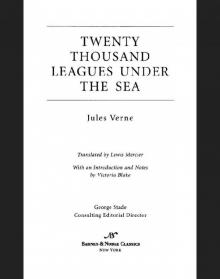- Home
- Jules Verne
20,000 Leagues Under the Sea
20,000 Leagues Under the Sea Read online
Table of Contents
Title Page
FOREWORD
PART ONE
CHAPTER I - A Shifting Reef
CHAPTER II - Pro and Con
CHAPTER III - I Form My Resolution
CHAPTER IV - Ned Land
CHAPTER V - At a Venture
CHAPTER VI - At Full Steam
CHAPTER VII - An Unknown Species of Whale
CHAPTER VIII - Mobilis in Mobili
CHAPTER IX - Ned Land’s Tempers
CHAPTER X - The Man of the Seas
CHAPTER XI - All By Electricity
CHAPTER XII - Some Figures
CHAPTER XIII - The Black River
CHAPTER XIV - A Note of Invitation
CHAPTER XV - A Walk on the Bottom of the Sea
CHAPTER XVI - A Submarine Forest
CHAPTER XVII - Four Thousand Leagues Under the Pacific
CHAPTER XVIII - Vanikoro
CHAPTER XIX - Torres Straits
CHAPTER XX - A Few Days on Land
CHAPTER XXI - Captain Nemo’s Thunderbolt
CHAPTER XXII - “Ægri Somnia”
CHAPTER XXIII - The Coral Kingdom
PART TWO
CHAPTER I - The Indian Ocean
CHAPTER II - A Novel Proposal of Captain Nemo’s
CHAPTER III - A Pearl of Ten Millions
CHAPTER IV - The Red Sea
CHAPTER V - The Arabian Tunnel
CHAPTER VI - The Grecian Archipelago
CHAPTER VII - The Mediterranean in Forty-Eight Hours
CHAPTER VIII - Vigo Bay
CHAPTER IX - A Vanished Continent
CHAPTER X - The Submarine Coal-Mines
CHAPTER XI - The Sargasso Sea
CHAPTER XII - Cachalots and Whales
CHAPTER XIII - The Iceberg
CHAPTER XIV - The South Pole
CHAPTER XV - Accident or Incident?
CHAPTER XVI - Want of Air
CHAPTER XVII - From Cape Horn to the Amazon
CHAPTER XVIII - The Poulps
CHAPTER XIX - The Gulf Stream
CHAPTER XX - From Latitude 47° 24’ to Longitude 17° 28’
CHAPTER XXI - A Hecatomb
CHAPTER XXII - The Last Words of Captain Nemo
CHAPTER XXIII - Conclusion
Afterword
Notes
Copyright Page
FOREWORD
Try, as hard as you can, to imagine a world where gasoline-powered automobiles abound, where airplanes and helicopters are commonplace, where people work to bring water to the Sahara Desert, where computers and calculators grind away, where audiovisual reproductions—pictures that actually move and talk—are part of daily life, where a trans-Siberian railway exists, where criminals are no longer beheaded but are instead electrocuted, where people travel by submarine to the depths of the oceans, and where a “photographic telegraph” allows anyone to send a facsimile of any message or design to the far reaches of the globe.
Sound familiar? Jules Verne, who predicted all of these things in the second half of the nineteenth century (one hundred years before the first fax machine), viewed the future with unusual clarity. In addition to these new technologies, he also predicted an explosive capable of destroying our planet, the widespread use of electricity, lasers, artificial rain, and a giant cannon that could be used to adjust the Earth’s axis. Strangest of all, perhaps, was his conception in 1865 of a moon rocket with practically the same dimensions as the actual Apollo 8. Furthermore, Verne’s imaginary vessel was launched from Florida, reached a top speed identical to the Apollo spacecraft, and splashed down only four kilometers away from the spot in the Pacific Ocean where Apollo 8 actually landed.
If, with the benefit of hindsight, all this seems easy, try to do it yourself. What will happen to the world during the next century? Imagine the cascading changes in all realms of technology. Imagine the condition of social, political, and religious institutions. Imagine, most challenging of all, the evolution (or lack thereof) of human consciousness, of the self-awareness and spiritual fulfillment of the species that chooses to call itself Homo sapiens.
What would such a world be like? And would you want to be part of it?
Jules Verne lived and breathed such questions. Although not all of his books are set in the future, by the time he died in 1905 he was one of the most famous storytellers ever and was known as someone who combined a talent for creating adventurous plots with a shrewdness for divining the path of technological change. Verne did not fully appreciate the accelerating rate of technological development, but his “instinct for the direction of science,” in the words of Leon Blum, informed by his extensive reading, remains unparalleled.
Verne did not take for granted the confidence of his readers, and therein lies a key to his success. He believed that such confidence must be earned, through the use of convincing detail. In addition, he believed, as I do, that no story has greater need of being grounded in honest, believable experience than a story attempting to carry its readers beyond the bounds of everyday experience. This approach requires both extensive research and a commitment to making all of the readers’ senses come fully alive.
Yet, as the reader of 20,000 Leagues Under The Sea will discover, Jules Verne was more than a brilliant futurist. He understood the importance of character development and tried to explore the often-baffling subtleties of interpersonal relationships. Captain Nemo, the enigmatic hero of the novel, is a complicated man, and his bond with his guest-and-prisoner, Professor Aronnax, is equally complicated. The novel is much richer for their intriguing relationship.
Nemo himself declares with great conviction: “The Nautilus is the ship of ships.” For the reader as well as the passenger, that is certainly true. Come aboard, then, for a journey to a world both very distant and very near.
—T.A. Barron
T.A. Barron is the author of Heartlight, The Ancient One, and The Merlin Effect, all published in paperback by Tor Books.
PART ONE
CHAPTER I
A Shifting Reef
THE YEAR 1866 was signalised by a remarkable incident, a mysterious and puzzling phenomenon, which doubtless no one has yet forgotten. Not to mention rumours which agitated the maritime population and excited the public mind, even in the interior of continents, seafaring men were particularly excited. Merchants, common sailors, captains of vessels, skippers, both of Europe and America, naval officers of all countries, and the Governments of several States on the two continents, were deeply interested in the matter.
For some time past vessels had been met by “an enormous thing,” a long object, spindle-shaped, occasionally phosphorescent, and infinitely larger and more rapid in its movements than a whale.
The facts relating to this apparition (entered in various log-books) agreed in most respects as to the shape of the object or creature in question, the untiring rapidity of its movements, its surprising power of locomotion, and the peculiar life with which it seemed endowed. If it was a whale, it surpassed in size all those hitherto classified in science. Taking into consideration the mean of observations made at divers times—rejecting the timid estimate of those who assigned to this object a length of two hundred feet, equally with the exaggerated opinions which set it down as a mile in width and three in length—we might fairly conclude that this mysterious being surpassed greatly all dimensions admitted by the learned ones of the day, if it existed at all. And that it did exist was an undeniable fact; and, with that tendency which disposes the human mind in favour of the marvellous, we can understand the excitement produced in the entire world by this supernatural apparition. As to classing it in the list of fables, the idea was out of the question.
On the 20th of July, 1866, the steamer Governor Higginson, of the Calcutta and Burnach Steam Navigation Company, had met this moving mass five miles off the east coast of Australia. Captain Baker thought at first that he was in the presence of an unknown sandbank; he even prepared to determine its exact position when two columns of water, projected by the mysterious object, shot with a hissing noise a hundred and fifty feet up into the air. Now, unless the sandbank had been submitted to the intermittent eruption of a geyser, the Governor Higginson had to do neither more nor less than with an aquatic mammal, unknown till then, which threw up from its blow-holes columns of water mixed with air and vapour.
Similar facts were observed on the 23rd of July in the same year, in the Pacific Ocean, by the Columbus, of the West India and Pacific Steam Navigation Company. But this extraordinary creature could transport itself from one place to another with surprising velocity; as, in an interval of three days, the Governor Higginson and the Columbus had observed it at two different points of the chart, separated by a distance of more than seven hundred nautical leagues.
Fifteen days later, two thousand miles farther off, the Helvetia, of the Compagnie-Nationale, and the Shannon, of the Royal Mail Steamship Company, sailing to windward in that portion of the Atlantic lying between the United States and Europe, respectively signalled the monster to each other in 42° 15’ N. lat. and 60° 35’ W. long. In these simultaneous observations they thought themselves justified in estimating the minimum length of the mammal at more than three hundred and fifty feet, as the Shannon and Helvetia were of smaller dimensions than it, though they measured three hundred feet over all.
Now the largest whales, those which frequent those parts of the sea round the Aleutian, Kulammak, and Umgullich islands, have never exceeded the length of sixty yards, if they attain that.
In every place of great resort the monster was the fashion. They sang of it in the cafés, ridiculed it in the papers, and represented it on the stage. All kinds of stories were circulated regarding it. There appeared in the papers caricatures of every gigantic and imaginary creature, from the white whale, the terrible “Moby Dick” of sub-arctic regions, to the immense kraken, whose tentacles could entangle a ship of five hundred tons and hurry it into the abyss of the ocean. The legends of ancient times were even revived.
Then burst forth the unending argument between the believers and the unbelievers in the societies of the wise and the scientific journals. “The question of the monster” inflamed all minds. Editors of scientific journals, quarrelling with believers in the supernatural, spilled seas of ink during this memorable campaign, some even drawing blood; for from the sea-serpent they came to direct personalities.
During the first months of the year 1867 the question seemed buried, never to revive, when new facts were brought before the public. It was then no longer a scientific problem to be solved, but a real danger seriously to be avoided. The question took quite another shape. The monster became a small island, a rock, a reef, but a reef of indefinite and shifting proportions.
On the 5th of March, 1867, the Moravian, of the Montreal Ocean Company, finding herself during the night in 27° 30’ lat. and 72° 15’ long., struck on her starboard quarter a rock, marked in no chart for that part of the sea. Under the combined efforts of the wind and its four hundred horsepower, it was going at the rate of thirteen knots. Had it not been for the superior strength of the hull of the Moravian, she would have been broken by the shock and gone down with the 237 passengers she was bringing home from Canada.
The accident happened about five o’clock in the morning, as the day was breaking. The officers of the quarterdeck hurried to the after-part of the vessel. They examined the sea with the most careful attention. They saw nothing but a strong eddy about three cables’ length distant, as if the surface had been violently agitated. The bearings of the place were taken exactly, and the Moravian continued its route without apparent damage. Had it struck on a submerged rock, or on an enormous wreck? They could not tell; but, on examination of the ship’s bottom when undergoing repairs, it was found that part of her keel was broken.
This fact, so grave in itself, might perhaps have been forgotten like many others if, three weeks after, it had not been re-enacted under similar circumstances. But, thanks to the nationality of the victim of the shock, thanks to the reputation of the company to which the vessel belonged, the circumstance became extensively circulated.
The 13th of April, 1867, the sea being beautiful, the breeze favourable, the Scotia, of the Cunard Company’s line, found herself in 15° 12’ long. and 45° 37’ lat. She was going at the speed of thirteen knots and a half.
At seventeen minutes past four in the afternoon, whilst the passengers were assembled at lunch in the great saloon, a slight shock was felt on the hull of the Scotia, on her quarter, a little aft of the port-paddle.
The Scotia had not struck, but she had been struck, and seemingly by something rather sharp and penetrating than blunt. The shock had been so slight that no one had been alarmed, had it not been for the shouts of the carpenter’s watch, who rushed on to the bridge, exclaiming, “We are sinking! we are sinking!” At first the passengers were much frightened, but Captain Anderson hastened to reassure them. The danger could not be imminent. The Scotia, divided into several compartments by strong partitions, could brave with impunity any leak. Captain Anderson went down immediately into the hold. He found that the sea was pouring into the fifth compartment; and the rapidity of the influx proved that the force of the water was considerable. Fortunately this compartment did not hold the boilers, or the fires would have been immediately extinguished. Captain Anderson ordered the engines to be stopped at once, and one of the men went down to ascertain the extent of the in jury. Some minutes afterwards they discovered the existence of a large hole, two yards in diameter, in the ship’s bottom. Such a leak could not be stopped; and the Scotia, her paddles half submerged, was obliged to continue her course. She was then three hundred miles from Cape Clear, and, after three days’ delay, which caused great uneasiness in Liverpool, she entered the basin of the company.
The engineers visited the Scotia, which was put in dry dock. They could scarcely believe it possible; at two yards and a half below water-mark was a regular rent, in the form of an isosceles triangle. The broken place in the iron plates was so perfectly defined that it could not have been more neatly done by a punch. It was clear, then, that the instrument producing the perforation was not of a common stamp and, after having been driven with prodigious strength, and piercing an iron plate 13/8 inches thick, had withdrawn itself by a backward motion.
Such was the last fact, which resulted in exciting once more the torrent of public opinion. From this moment all unlucky casualties which could not be otherwise accounted for were put down to the monster.
Upon this imaginary creature rested the responsibility of all these shipwrecks, which unfortunately were consider able; for of three thousand ships whose loss was annually recorded at Lloyd’s, the number of sailing and steam-ships supposed to be totally lost, from the absence of all news, amounted to not less than two hundred!
Now, it was the “monster” who, justly or unjustly, was accused of their disappearance, and, thanks to it, communication between the different continents became more and more dangerous. The public demanded sharply that the seas should at any price be relieved from this formidable cetacean.1
CHAPTER II
Pro and Con
AT THE PERIOD when these events took place, I had just returned from a scientific research in the disagreeable territory of Nebraska, in the United States. In virtue of my office as Assistant Professor in the Museum of Natural History in Paris, the French Government had attached me to that expedition. After six months in Nebraska, I arrived in New York towards the end of March, laden with a precious collection. My departure for France was fixed for the first days in May. Meanwhile I was occupying myself in classifying my mineralogical, botanical, and zoological riches, when the accident happen
ed to the Scotia.
I was perfectly up in the subject which was the question of the day. How could I be otherwise? I had read and reread all the American and European papers without being any nearer a conclusion. This mystery puzzled me. Under the impossibility of forming an opinion, I jumped from one extreme to the other. That there really was something could not be doubted, and the incredulous were invited to put their finger on the wound of the Scotia.
On my arrival at New York the question was at its height. The theory of the floating island, and the unapproachable sandbank, supported by minds little competent to form a judgment, was abandoned. And, indeed, unless this shoal had a machine in its stomach, how could it change its position with such astonishing rapidity?
From the same cause, the idea of a floating hull of an enormous wreck was given up.
There remained, then, only two possible solutions of the question, which created two distinct parties: on one side, those who were for a monster of colossal strength; on the other, those who were for a submarine vessel of enormous motive power.
But this last theory, plausible as it was, could not stand against inquiries made in both worlds. That a private gentleman should have such a machine at his command was not likely. Where, when, and how was it built? and how could its construction have been kept secret? Certainly a Government might possess such a destructive machine. And in these disastrous times, when the ingenuity of man has multiplied the power of weapons of war, it was possible that, without the knowledge of others, a State might try to work such a formidable engine.
But the idea of a war machine fell before the declaration of Governments. As public interest was in question, and transatlantic communications suffered, their veracity could not be doubted. But how admit that the construction of this submarine boat had escaped the public eye? For a private gentleman to keep the secret under such circumstances would be very difficult, and for a State whose every act is persistently watched by powerful rivals, certainly impossible.

 Michael Strogoff; Or the Courier of the Czar: A Literary Classic
Michael Strogoff; Or the Courier of the Czar: A Literary Classic Voyage au centre de la terre. English
Voyage au centre de la terre. English Journey Through the Impossible
Journey Through the Impossible The Castaways of the Flag
The Castaways of the Flag L'île mystérieuse. English
L'île mystérieuse. English Maître du monde. English
Maître du monde. English Around the World in Eighty Days
Around the World in Eighty Days A Voyage in a Balloon
A Voyage in a Balloon From the Earth to the Moon, Direct in Ninety-Seven Hours and Twenty Minutes: and a Trip Round It
From the Earth to the Moon, Direct in Ninety-Seven Hours and Twenty Minutes: and a Trip Round It Paris in the Twentieth Century
Paris in the Twentieth Century City in the Sahara - Barsac Mission 02
City in the Sahara - Barsac Mission 02 The English at the North Pole
The English at the North Pole The Field of Ice
The Field of Ice From the Earth to the Moon
From the Earth to the Moon Un capitaine de quinze ans. English
Un capitaine de quinze ans. English The Mysterious Island
The Mysterious Island Les indes-noirs. English
Les indes-noirs. English Robur-le-conquerant. English
Robur-le-conquerant. English Propeller Island
Propeller Island Around the World in Eighty Days. Junior Deluxe Edition
Around the World in Eighty Days. Junior Deluxe Edition Les forceurs de blocus. English
Les forceurs de blocus. English In the Year 2889
In the Year 2889 Journey to the Centre of the Earth
Journey to the Centre of the Earth Twenty Thousand Leagues Under the Sea
Twenty Thousand Leagues Under the Sea From the Earth to the Moon; and, Round the Moon
From the Earth to the Moon; and, Round the Moon Vingt mille lieues sous les mers. English
Vingt mille lieues sous les mers. English Cinq semaines en ballon. English
Cinq semaines en ballon. English Twenty Thousand Leagues under the Seas
Twenty Thousand Leagues under the Seas Face au drapeau. English
Face au drapeau. English Michael Strogoff; Or, The Courier of the Czar
Michael Strogoff; Or, The Courier of the Czar Un billet de loterie. English
Un billet de loterie. English The Secret of the Island
The Secret of the Island Off on a Comet! a Journey through Planetary Space
Off on a Comet! a Journey through Planetary Space Into the Niger Bend: Barsac Mission, Part 1
Into the Niger Bend: Barsac Mission, Part 1 All Around the Moon
All Around the Moon A Journey to the Center of the Earth - Jules Verne: Annotated
A Journey to the Center of the Earth - Jules Verne: Annotated 20000 Lieues sous les mers Part 2
20000 Lieues sous les mers Part 2 Robur-le-Conquerant
Robur-le-Conquerant Les Index Noires
Les Index Noires Michael Strogoff; or the Courier of the Czar
Michael Strogoff; or the Courier of the Czar 20000 Lieues sous les mers Part 1
20000 Lieues sous les mers Part 1 Twenty Thousand Leagues Under the Sea (Barnes & Noble Classics Series)
Twenty Thousand Leagues Under the Sea (Barnes & Noble Classics Series) Five Weeks In A Balloon
Five Weeks In A Balloon Journey to the Center of the Earth
Journey to the Center of the Earth 20,000 Leagues Under the Sea
20,000 Leagues Under the Sea Journey to the Center of the Earth (Barnes & Noble Classics Series)
Journey to the Center of the Earth (Barnes & Noble Classics Series) Adrift in the Pacific-Two Years Holiday
Adrift in the Pacific-Two Years Holiday The Collected Works of Jules Verne: 36 Novels and Short Stories (Unexpurgated Edition) (Halcyon Classics)
The Collected Works of Jules Verne: 36 Novels and Short Stories (Unexpurgated Edition) (Halcyon Classics) The Survivors of the Chancellor
The Survivors of the Chancellor Their Island Home
Their Island Home Le Chateau des Carpathes
Le Chateau des Carpathes Les Cinq Cents Millions de la Begum
Les Cinq Cents Millions de la Begum The Floating Island
The Floating Island Cinq Semaines En Ballon
Cinq Semaines En Ballon Autour de la Lune
Autour de la Lune